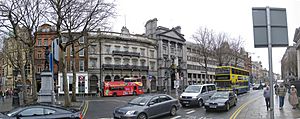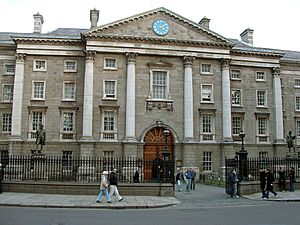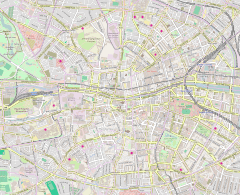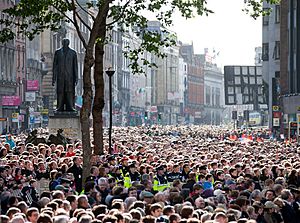College Green, Dublin facts for kids
| Faiche an Choláiste | |
 |
|
| Namesake | Trinity College, Dublin |
|---|---|
| Length | 260 m (850 ft) |
| Width | 38 metres (125 ft) |
| Location | Dublin, Ireland |
| Postal code | D02 |
| Coordinates | 53°20′40″N 6°15′36″W / 53.34444°N 6.26000°W |
| west end | Dame Street |
| east end | Trinity College, Westmoreland Street, College Street |
| Other | |
| Known for | Trinity College, restaurants, nightclubs, statues, |

College Green (Irish: Faiche an Choláiste) is a famous open space in the centre of Dublin, Ireland. It is shaped like a triangle. On its northern side is the Bank of Ireland building. This building was once Ireland's Parliament House until 1800. To its east stands Trinity College Dublin, a very old university. On its south side are many 19th-century buildings, mostly banks.
Several streets lead into College Green. These include Dame Street to the west, Grafton Street to the south, and Westmoreland Street to the north. College Green is often used for big public gatherings and political events. For example, in the 1990s, US President Bill Clinton spoke to a crowd here. Later, President Barack Obama also gave a major speech at this spot in May 2011.
Contents
History of College Green
This area was once known as Hoggen Green. Its name came from an Old Norse word, haugr, which means 'mound' or 'hill'. There were several burial mounds here. People believe these mounds held the remains of some of the Norse kings of Dublin.
A convent called St Mary de Hogges was built here in 1156. It stood roughly where the Bank of Ireland is today. This convent owned a lot of land in the area. The site has always been a place for celebrations. New leaders of Ireland were often welcomed on this street.
Trinity College was founded on the east side of College Green in 1592. The beautiful front of the college was designed by Theodore Jacobsen and added in 1751.
Statues and Monuments
Many public statues stand in College Green. One is a 19th-century statue of Henry Grattan. He was an important member of the old Irish Parliament.
A statue of King William III of England on horseback was built in the middle of College Green in 1701. It was made by Grinling Gibbons. This statue was attacked and damaged many times over the years. It was finally taken down in 1928 after a big explosion. Its head was even stolen in 1929.
In 1966, a statue of the poet and nationalist Thomas Davis was put in College Green. This was to mark 50 years since the Easter Rising. The statue includes a fountain designed by Edward Delaney.
Buildings and Architecture
The building that is now the Bank of Ireland has a long history. It was first Chichester House, built in the early 1600s. It became the Irish Parliament House around 1670. A new Parliament House was built in 1729. It was later made bigger in 1787 and again between 1804 and 1808.
Daly's Club was a famous gambling house and club. It moved to College Green in 1769. It closed in 1823. Today, shops are in the middle part of its old location.
Numbers 6-8 College Green used to be Jury's Hotel. It opened in 1839. The hotel was rebuilt several times. It was sold in 1979, and the building was knocked down in 1980. A new office block was built there, which is now Blooms Hotel.
The Ulster Bank headquarters on College Green was built in the late 1970s. Many older buildings were taken down to make way for it. The old Victorian front of the building was kept, but the inside was completely changed.
College Green and Politics
College Green is famous for its role in Irish politics. A painting by Francis Wheatley shows the Irish Volunteers protesting for independence here in 1779.
Many important leaders have visited College Green. In December 1995, Bill Clinton, the President of the United States, gave a speech to 80,000 people here. In May 2011, President Barack Obama spoke to 100,000 people. He praised Ireland's opportunities and spoke about his Irish family background.
Traffic and Future Plans
Since 2009, during busy times on weekdays, only buses, taxis, cyclists, and people walking can use College Green.
There are ongoing discussions about making College Green a pedestrian-only area. This would create a large public space in front of the Bank of Ireland. Plans for this were made in 2016. However, the state planning agency did not approve the full pedestrianisation plan in 2018. The Green Party in Dublin City Council is still trying out temporary pedestrian-only periods in 2019.
Images for kids
See also
 In Spanish: College Green para niños
In Spanish: College Green para niños





